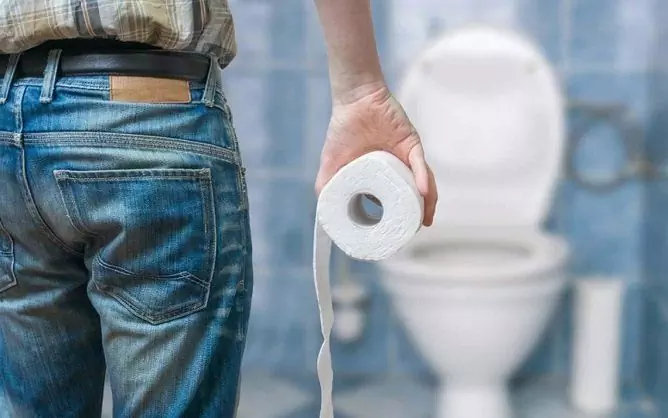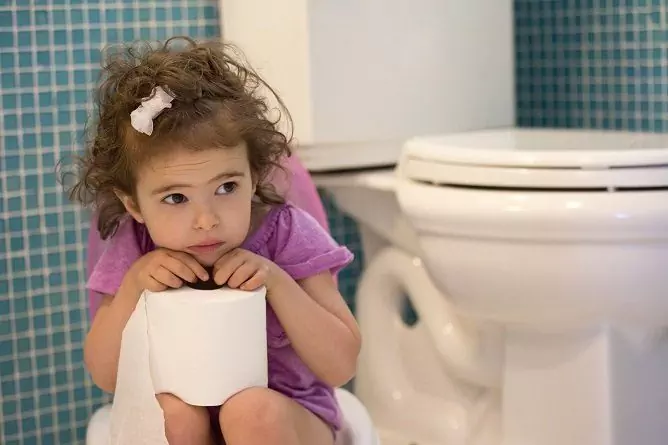- Author Rachel Wainwright [email protected].
- Public 2023-12-15 07:39.
- Last modified 2025-11-02 20:14.
Constipation in children: causes and treatment with normoflorins
Even the smallest children often have problems with the functioning of the intestines. Bloating, nausea, diarrhea, flatulence and colic are just a few of the more common manifestations of this delicate problem. Constipation in a child is very common. The reasons for the failure of intestinal motility can be very different.

Why do babies have constipation?
One of the most common causes of constipation in the smallest children is colic, which occurs due to the immaturity of the gastrointestinal tract.
What other factors can cause constipation in children? Professionals identify the following reasons that contribute to the violation of bowel movements in infants:
- lack of fiber of plant origin in the mother's diet;
- lactase deficiency;
- anusitis;
- wrong feeding.
In addition, malnutrition is one of the reasons for constipation in older children: children often refuse to eat vegetables. And the lack of fiber, which is found in vegetables, also causes constipation (and microflora disorders).
All these factors can not only provoke constipation, but also lead to significant problems in the normal functioning of the intestines and the entire gastrointestinal system. The listed factors are a direct path to the formation of intestinal soaps that aggravate the child's condition if normal bowel movements are impossible. They affect the state of microflora extremely negatively, which is manifested in the hardening of feces. As a result, there is a significant reduction in the number of urge to defecate. Babies experience colic in the abdomen, severe pain and loss of appetite.

Types of constipation and their symptoms
The correct digestion process is accompanied by a wave-like contraction of the intestinal walls. This action helps to push the digested food towards the outlet. This is the intestinal motility or peristalsis. However, in some cases it can be broken. Often the reason for this is various diseases, for example, hypothyroidism or rickets. Experts note that these constipation provocateurs are extremely rare. In most cases, the problem is caused by a disturbance in the functioning of the intestine itself.
In the case of spastic constipation, the baby has:
- severe and sharp pain in the abdomen;
- discomfort during bowel movements;
- "Sheep feces", when the stool is very dense and consists of small, smooth pellets.
Usually this ailment becomes a consequence of intestinal spasms. The problem is explained by the too high contractile activity of this organ.
There is another type of constipation in children. It is called atonic. Its manifestations include bloating, complete absence of urge to defecate, rare bowel movements, and a large amount of feces. Usually this type of problem is associated with excessively low activity of the intestinal muscles.
On a note! With atonic constipation, coercive measures in the form of prolonged planting of the baby on a pot can only lead to an aggravation of the problem. After all, a child has a negative perception of defecation on a subconscious level
Common causes of bowel problems
Many parents start potty training too early. If this happens forcibly and causes a real conflict, resistance in the child, then the so-called psychogenic constipation may occur. A similar pathology also arises due to uncomfortable, unsanitary, embarrassing conditions at school or kindergarten. Poor state of the bathroom, which repels the child, the possibility of being seen by strangers lead to problems with bowel movements. The thing is that the baby gets used to endure and does it even at home.

Neoplasms, narrowings, tumors - this is another number of reasons why a baby may have a lack of normal defecation. Among the provocateurs of a delicate problem, one cannot fail to note the long-term use of antibiotics. If the baby is breastfed and receives nutrition only in the form of mother's milk, then constipation may be caused by her improper diet or taking certain medications. In this situation, the microflora, the average weight of which is about 3 kg, is disturbed.
Therefore, the occurrence of such a delicate problem can be caused by dysbiosis. This concomitant state of many diseases manifests itself not only in the form of constipation. Other symptoms include:
- decreased appetite;
- flatulence;
- stomach ache;
- bad breath;
- intestinal colic.
The whole point is that dysbiosis is that state of the intestinal microflora when the ratio of beneficial and harmful bacteria is violated. The number of important lacto- and bifidobacteria is significantly reduced, which constitute about 95% of the beneficial microenvironment of the gastrointestinal tract.
As a rule, the cause of dysbiosis and constipation is associated with prolonged or uncontrolled use of antibiotics. These drugs do more than cure by helping to kill harmful bacteria. Powerful agents also destroy beneficial microorganisms. In this situation, it will be extremely difficult to normalize the optimal functioning of the gastrointestinal tract. If you do not help the body with special drugs, the microflora will recover from its own reserves for about 4 years.
Violation of microflora is also associated with the transfer of intestinal infections by the child. In infants, constipation and dysbiosis can occur against the background of the use of unadapted formulas with artificial feeding. There may also be wrong complementary foods.
Some methods of correcting constipation in children
Treatment of constipation in children cannot be carried out without consulting a pediatrician. Most doctors advise to solve a serious problem:
- carry out a light massage;
- use a special gas tube for babies;
- introduce proper nutrition for children who are not breastfed.
At the same time, doctors always conduct a complete examination of the baby to identify the true cause of the pathology. If no irreversible deviations are found, then it is advisable to introduce foods enriched with fiber and dietary fiber into the diet. It is great if the child eats vinaigrette, raw fruits and vegetables, crumbly cereals, salads, soups with vegetable broths, poultry and meat.
Another prerequisite for restoring a correct bowel movement is drinking enough water daily. The child should receive liquid not only from soups and fruits. He needs clean water that activates intestinal motility.
Another popular solution to the problem is the use of an enema. If constipation is of an episodic nature, then this remedy can in rare cases be used. Often it is impossible to put enemas, as they contribute to the suppression of the natural urge to defecate. Simply put, the child gets used to this kind of help and can no longer go to the toilet himself.

The use of enemas must be correct. It is very important to consider the age of the baby:
- at 6-12 months, 120 to 180 ml are administered;
- for 3-6 months, 90 ml is enough;
- at 1-3 months you can use a maximum of 40 ml;
- up to 1 month, no more than 30 ml is administered.
It is not recommended to use liquid that is too warm. The optimum water temperature for an enema is 22-24 degrees.
Note! Under the influence of too warm liquid, toxic substances that have accumulated in the intestines quickly dissolve and are absorbed into the bloodstream
If an enema is an exceptional method, then the use of baby oil and soap for introduction into the rectum should be abandoned altogether.
Normoflorins in the treatment of constipation in children
Professionals recommend not just eliminating the very manifestation of constipation, but "hitting" directly for the reason that caused the pathology. If this is dysbiosis, then it is extremely important to restore the optimal number of beneficial microorganisms in the digestive tract. Modern medicines help to "return" bifidobacteria and lactobacilli. An excellent solution would be to use normoflorins. It should be noted that these drugs are not laxatives, which, by the way, are not recommended for children. These are new generation products that work efficiently and delicately.
Liquid probiotics are completely safe for babies. They can be used after consulting a pediatrician even in the first months of a newborn's life. The whole point is that only natural substances are present in the composition of normoflorins:
- bacterial metabolites;
- lactitol, or galactooligosaccharide lactitol;
- bifidobacteria and lactobacilli, which are physiologically active, living cultures.
Valuable substances do not cause side effects and addiction. That is why liquid probiotics can be given to babies from the first days of life.

The listed unique tools are different. These are Normoflorin-D and Normoflorin-B. However, Normoflorin-L is the most effective in the treatment of childhood constipation by restoring the intestinal microflora.

The composition of the liquid synbiotic is unique. An innovative safe product includes valuable amino acids, macro- and microelements, natural antimicrobial components, a number of vitamins, succinic and lactic acids. Also, this probiotic includes prebiotic lactitol, which is important for the restoration of intestinal microflora. It is this unique component that awakens and activates the growth of protective microorganisms in the digestive tract.
Normoflorin-L - a modern method for eliminating constipation in children
The modern biocomplex operates delicately, but very productively. Normoflorin-L perfectly removes toxins and other harmful substances from the tissues of the body that provoke the formation of problems with regular emptying. The composition extremely quickly eliminates not only the symptoms of dysbiosis, but also its causes. A unique agent effectively suppresses the activity of pathogenic microorganisms. A liquid probiotic in an extremely short time normalizes intestinal motility, since it contains a large amount of organic acids. Normoflorin-L promotes the breakdown of lactose and reduces the level of oxalates and cholesterol in the body.

This is not all that a modern innovative tool is capable of. The biocomplex activates the production of immunoglobulins. The product stimulates all metabolic mechanisms in the child's body, providing a protective effect on weak cells. Normoflorin-L is a truly effective agent, a biocomplex that has a long-lasting effect. It continues to "work" even after the withdrawal of this probiotic.
Found a mistake in the text? Select it and press Ctrl + Enter.






